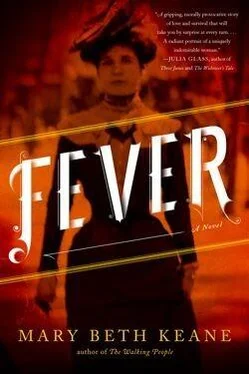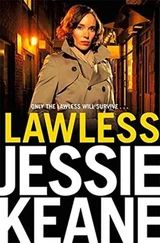Mary had taken one step out the door to the alley when she thought to explain to Evelyn what had happened. How would she put it? With only a few seconds, how to make her understand?
“I used to cook for a family uptown, and they said—”
“Oh, I followed your case,” Evelyn said, pushing her out with more force. “I recognized you on the first day.”
Mary gaped at the woman, and Evelyn shrugged. “You didn’t lie. You told your name. Go on now, Mary. Good luck.”
Clutching the box of pastries and with her bag of bread pinned under her arm, Mary ran down the alley and out onto the avenue.
Mila watched in silence as Mary swept her powders and creams from the sill. In the twenty months that she’d lived there, Mary was careful to keep her things within the space she’d been allotted: under her cot, the windowsill, a shelf in the pantry, one drawer in Mila’s dresser. “Where will you go?” Mila asked as Mary shoved her belongings in her old velvet satchel.
“I don’t know,” Mary said as she looked around for the boys’ scratch pads. But when she found them and touched the tip of the pencil to the paper, she realized she didn’t know what to say. She drew a picture of a bird, and below it, two stick-figure boys holding hands.
“What will you do?” Mary asked as she picked up her satchel and placed it at the door.
“What will you do? You write to tell me where you land,” she said, and Mary swore that she would. “And you’ll come back, won’t you? After everything has settled down?”
“Yes, yes. Of course.”
“Why don’t you go down and stay with Fran for a while? If they knock I’ll tell them I haven’t seen you.”
Mary imagined Soper showing up with an army of policemen behind him. She imagined them staking out the entrance of the building, kicking down doors, throwing back bedclothes, and peering into closets.
“I’m sorry. I just have to go.”
She had been rushing since she left the bakery and felt breathless, faster than everything moving around her. She passed Fran’s floor without slowing, passed Joan’s door, glanced down the hall toward Driscoll’s old rooms, where a young man had been living for a year, and when she burst out onto the sidewalk she bent her head and walked north for no reason except that there were fewer people in that direction, and she’d be able to walk faster. She hopped onto the trolley on Thirty-Sixth Street, and held on as it turned, then came to an abrupt stop to let a dog cross the track, and again a half block later to let people on. She exited at the rear and hoisted her bag over her shoulder.
There had been no trace of Alfred since she left him behind in the vestibule that early winter morning almost a year and a half earlier, and she considered going to Nation’s to find out if they’d seen him, but when she got her chance she kept going, past the bright blue door, past his other favorite spots. She arrived at Grand Central Terminal, where she dodged the trolleys approaching from every direction, and entered the building. Once inside, she followed the ramps up and around until she came to the main waiting area, the ceiling so distant it might as well have been the sky, and found an empty space on one of the long benches lined up before the timetable.
Every person who passed her was on his or her way someplace. Those seated looked up at the board once in a while, then at the clock, then back down at their hands to wait a few minutes longer. The announcer made a boarding call for Scarsdale, for Poughkeepsie. From behind her they called for Philadelphia. The best dressed waited in a separate area for the Twentieth Century Limited to Chicago. She scanned the boards for a train to Dobbs Ferry, and then watched closely as the people who wanted that train stood up, checked behind them for forgotten items, hurried off. The announcer made another boarding call. Another. Mary moved her bag from her lap to the floor by her feet and felt her back bend to the curve in the wood. She touched her fingertips to her closed eyelids and felt a tingle in her nose, the sob that had been brewing there all day rise up like a wave lifts itself from the rest of the ocean, rushes forth, spreads itself on shore.
“Madam?” a man tapped her on the shoulder. He wore a uniform: a jacket and matching cap. “Would you like to wait in the women’s parlor? Do you know where it is?”
Mary thought he meant the lav, so when he led her to a large oak door and knocked twice, and then told the woman who answered that Mary just needed to rest, and should not be charged the twenty-five-cent fee, she felt afraid that he’d misunderstood something about her, and when they found her out, there would be trouble. But he encouraged her forward, and the woman who opened the door led her first through a small room where women’s light spring coats were hung, and then into a larger room, finished in quartered oak, a Persian-style rug covering the floor. She pointed out one of several rocking chairs. “Thank you,” she said to the woman, and the woman gave Mary a small curtsy as she backed away. Mary registered the small round vanity mirrors placed here and there, the full-length mirrors by the changing rooms. Though it was set up like a lounge in a private home, every step of a woman’s toilet was available for sale, and adjoining the oak-paneled room was a fingernail manicuring room, a shoe polisher, a hairstylist, a seamstress. There was an area where a woman could change from traveling clothes to evening clothes, and women in blue uniforms bustled about to help them. One approached Mary, reached for her bag, but Mary clutched it closer, and the woman went away.
She could have stayed in that warm and gleaming room for a month, but they wouldn’t have let her, and so what was the point of staying for even an hour if she knew she’d have to leave again, eventually, and had nowhere to go. She studied a painting on the wall — a river, a field of flowers — and remembered her promise to John Cane that she’d look him up, go walking with him one day. She could go to him, she knew. She could meet the ferry and when he got off she could approach him, tell him what had happened, ask if she could stay with him for a while, and he would let her. She’d have to listen to him, and he might pretend at first that he wouldn’t let her, but he would, in the end. She knew he would. Or he might know of someone who needed a boarder. There was a brother, too, she remembered, something wrong with him, but nothing she couldn’t handle, she was sure, just until she got on her feet. She would be kind to him.
But when she left the ladies’ parlor and made for the uptown IRT, she paused only for a second at the top of the steps before she walked on, walked east, back to the boardinghouse where she’d stayed before finding her cot at Mrs. Post’s. If the woman remembered her she made no sign, and as she was led up the back stairs she knew before they stopped at a door that it would be the same room she’d slept in back in 1910. “Breakfast at seven,” the woman said, and when Mary shut the door and dropped the latch, she collapsed onto the narrow bed and slept.
Breakfast was two rows of glum faces spooning porridge into their mouths, chewing, swallowing. Mary pushed away her plate. When she stepped out into the sun a dozen pigeons clucked and flew off as one. Along with the loose gray-black spots they left on the sidewalk were feathers, old milk cartons, a box of cracker meal broken open and left now to be blown around in the breeze.
With her bag slung over her shoulder, she walked for an hour. West, mostly, but also south. She stopped to stuff paper into the heel of her shoe. Her shoulder ached. At ten she stopped at a park, took off her shoes, and walked on the grass behind the benches while she ate a pear. When there was not a single bit of flesh left on the fruit, she picked up her bag and continued south, until she came to City Hall, and across from City Hall, the almost-complete skyscraper where Jimmy Tiernan spent his days hanging dozens of stories above the sidewalk, guiding terra-cotta panels into place. The pyramid at the top made the whole thing feel like a cathedral, Mary thought, as she tipped her head back and gazed up.
Читать дальше












